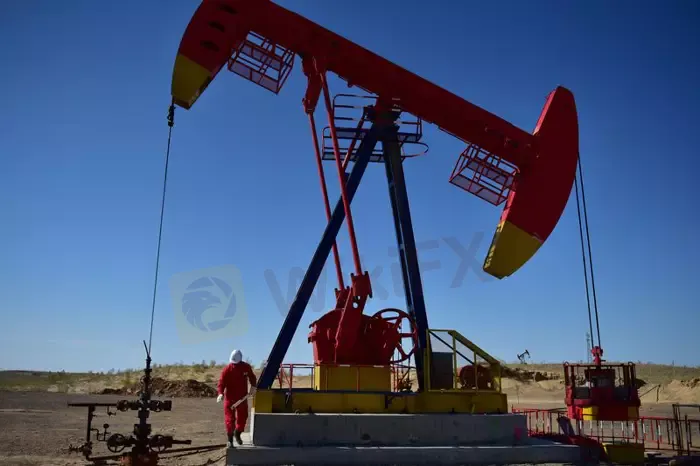简体中文
繁體中文
English
Pусский
日本語
ภาษาไทย
Tiếng Việt
Bahasa Indonesia
Español
हिन्दी
Filippiiniläinen
Français
Deutsch
Português
Türkçe
한국어
العربية
Oil prices rebound on supply concerns after drop to near 6-month low
Abstract:Oil prices rose in early Asian trade on Thursday, bouncing off multi-month lows in the previous session caused by data signalling weak U.S. fuel demand.

Brent crude futures rose 42 cents, or 0.4%, at $97.20 a barrel by 0250 GMT, while West Texas Intermediate (WTI) crude futures was last up 49 cents, a 0.5% gain, at $91.15.
Both benchmarks fell to their weakest levels since February in the previous session after U.S. data showed crude and gasoline stockpiles unexpectedly surged last week and as OPEC+ agreed to raise its oil output target by 100,000 barrels per day (bpd), equal to about 0.1% of global oil demand.
The Organization of the Petroleum Exporting Countries (OPEC) and allies including Russia, known as OPEC+, have been previously increasing production but have struggled to meet targets as most members have already exhausted their output potential.
“OPEC+ agreed to increase production by 100,000 barrels per day in September, far lower than previous months production. The global energy market still faces supply shortages,” said Leon Li, an analyst at CMC Markets.
He added that WTI oil prices are “likely to oscillate” between $90 and $100 a barrel.
While the United States has asked the group to boost output, spare capacity is limited and Saudi Arabia may be reluctant to beef up production at the expense of Russia, hit by sanctions over the Ukraine invasion that Moscow calls “a special operation”.
Ahead of the meeting, OPEC+ had trimmed its forecast for the oil market surplus this year by 200,000 barrels per day (bpd) to 800,000 bpd, three delegates told Reuters.
“It looks like OPEC+ is resisting calls to boost output because the crude demand outlook continues to get slashed. The world is battling the ongoing global energy crisis and it wont be getting any help from OPEC+,” Edward Moya, senior analyst with OANDA, said in a note.
“The oil market will remain tight over the short term and that means we should still have limited downside here. Crude prices should find strong support around the $90 level and eventually will rebound towards the $100 barrel level even as the global economic slowdown accelerates.”
Oil‘s demand outlook has been clouded by rising fears of an economic slump in the United States and Europe, debt distress in emerging market economies, and a strict zero COVID-19 policy in China, the world’s largest oil importer.
U.S. crude oil inventories had also rose unexpectedly last week as exports fell and refiners lowered runs, while gasoline stocks also posted a surprise build as demand slowed, the Energy Information Administration said.
Supporting prices on Thursday, however, the Caspian Pipeline Consortium (CPC), which connects Kazakh oil fields with the Russian Black Sea port of Novorossiisk, said that supplies were significantly down, without providing figures.

Disclaimer:
The views in this article only represent the author's personal views, and do not constitute investment advice on this platform. This platform does not guarantee the accuracy, completeness and timeliness of the information in the article, and will not be liable for any loss caused by the use of or reliance on the information in the article.
Read more

The Withdrawal Trap: How Scam Brokers Lure Victims into Paying More
In the world of online trading, the promise of quick profits and seamless transactions often masks a darker reality. One of the most insidious tactics employed by fraudulent brokers is blocking withdrawals, that is a deliberate strategy designed to trap traders and investors into paying more money under false pretences.

Common Tactics Used in Online Trading Fraud Today
Know the top online trading scams of 2025, from fake apps to pump-and-dump tricks. Simple tips to spot and avoid them, keeping your money safe in this easy guide.

RM1.29 Million Lost in ‘C Baird VIP’ WhatsApp Scam
A 43-year-old company auditor and subcontractor in Malaysia became the latest victim of an elaborate investment scam after losing RM1.29 million to a fraudulent scheme promoted via WhatsApp.

U.S. March ISM Manufacturing PMI Released
The U.S. March ISM Manufacturing PMI data shows that manufacturing has contracted for the first time, and investors should pay attention to future changes and impacts on the sector.
WikiFX Broker
Latest News
Exposing the Top 5 Scam Brokers of March 2025: A Closer Look by WikiFX
Gold Prices Climb Again – Have Investors Seized the Opportunity?
Webull Launches SMSF Investment Platform with Zero Fees
Australian Regulator Warns of Money Laundering and Fraud Risks in Crypto ATMs
FCA Warns Against 10 Unlicensed or Clone Firms
CySEC Warns Against 14 Unlicensed Investment Websites
Top Currency Pairs to Watch for Profit This Week - March 31, 2025
Will natural disasters have an impact on the forex market?
Philippines Deports 29 Indonesians Linked to Online Scam Syndicate in Manila
The Withdrawal Trap: How Scam Brokers Lure Victims into Paying More
Currency Calculator








